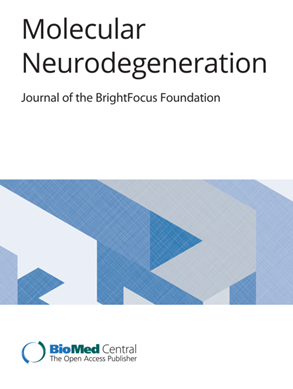Cerebrospinal fluid proteome profiling across the Alzheimer's disease continuum: a step towards solving the equation for 'X'.
IF 17.5
1区 医学
Q1 NEUROSCIENCES
引用次数: 0
Abstract
BACKGROUND While the temporal profile of amyloid (Aβ) and tau cerebrospinal fluid (CSF) biomarkers along the Alzheimer's disease (AD) continuum is well-studied, chronological changes of CSF proteins reflecting other disease-relevant processes, denoted 'X' in the ATX(N) framework, remain poorly understood. METHODS Using an untargeted mass spectrometric approach termed tandem mass tag (TMT), we quantified over 1500 CSF proteins across the AD continuum in three independent cohorts, finely staged by Aβ/tau positron emission tomography (PET), fluid biomarkers, or brain biopsy. Weighted protein co-expression network analysis identified clusters of proteins robustly correlating in all three cohorts which sequentially changed with AD progression. Obtained protein clusters were correlated with fluid biomarker measurements (phosphorylated tau (p-tau) species including p-tau181, p-tau217, and p-tau205, as well as Aβ), Aβ/tau PET imaging, and clinical parameters to discern disease-relevant clusters which were modelled across the AD continuum. RESULTS Neurodegeneration-related proteins (e.g., 14-3-3 proteins, PPIA), derived from different brain cell types, strongly correlated with fluid as well as imaging biomarkers and increased early in the AD continuum. Among them, the proteins SMOC1 and CNN3 were highly associated with Aβ pathology, while the 14-3-3 proteins YWHAZ and YWHAE as well as PPIA demonstrated a strong association with both Aβ and tau pathology as indexed by PET. Endo-lysosomal proteins (e.g., HEXB, TPP1, SIAE) increased early in abundance alongside neurodegeneration-related proteins, and were followed by increases in metabolic proteins such as ALDOA, MDH1, and GOT1 at the mild cognitive impairment (MCI) stage. Finally, later AD stages were characterized by decreases in synaptic/membrane proteins (e.g., NPTX2). CONCLUSIONS Our study identified proxies of Aβ and tau pathology, indexed by PET, (SMOC1, YWHAE, CNN3) and highlighted the dynamic fluctuations of the CSF proteome over the disease course, identifying candidate biomarkers for disease staging beyond Aβ and tau.跨阿尔茨海默病连续体的脑脊液蛋白质组分析:朝着解决“X”方程迈出的一步。
背景:虽然淀粉样蛋白(Aβ)和tau脑脊液(CSF)生物标志物沿阿尔茨海默病(AD)连续体的时间谱已经得到了很好的研究,但反映其他疾病相关过程的CSF蛋白的时间变化,在ATX(N)框架中表示为“X”,仍然知之甚少。方法:使用一种称为串联质量标签(TMT)的非靶向质谱方法,我们在三个独立的队列中对AD连续体中的1500多个CSF蛋白进行了量化,通过Aβ/tau正电子发射断层扫描(PET)、液体生物标志物或脑活检进行了精细分期。加权蛋白共表达网络分析发现,在所有三个队列中,随着阿尔茨海默病的进展而顺序变化的蛋白簇具有强相关性。获得的蛋白质簇与流体生物标志物测量(磷酸化tau (p-tau)物种,包括p-tau181、p-tau217和p-tau205,以及Aβ)、Aβ/tau PET成像和临床参数相关,以识别在AD连续体中建模的疾病相关簇。结果来自不同脑细胞类型的神经变性相关蛋白(如14-3-3蛋白、PPIA)与液体和成像生物标志物密切相关,并在AD连续体的早期增加。其中,SMOC1和CNN3蛋白与a β病理高度相关,而14-3-3蛋白YWHAZ和YWHAE以及PPIA与a β和tau病理均有很强的相关性。内溶酶体蛋白(如HEXB, TPP1, SIAE)与神经退行性相关蛋白一起早期丰富度增加,随后在轻度认知障碍(MCI)阶段代谢蛋白如ALDOA, MDH1和GOT1增加。最后,晚期AD的特征是突触/膜蛋白(如NPTX2)的减少。我们的研究确定了以PET、(SMOC1、YWHAE、CNN3)为指标的Aβ和tau病理指标,并强调了脑脊液蛋白质组在疾病过程中的动态波动,确定了Aβ和tau以外疾病分期的候选生物标志物。
本文章由计算机程序翻译,如有差异,请以英文原文为准。
求助全文
约1分钟内获得全文
求助全文
来源期刊

Molecular Neurodegeneration
医学-神经科学
CiteScore
23.00
自引率
4.60%
发文量
78
审稿时长
6-12 weeks
期刊介绍:
Molecular Neurodegeneration, an open-access, peer-reviewed journal, comprehensively covers neurodegeneration research at the molecular and cellular levels.
Neurodegenerative diseases, such as Alzheimer's, Parkinson's, Huntington's, and prion diseases, fall under its purview. These disorders, often linked to advanced aging and characterized by varying degrees of dementia, pose a significant public health concern with the growing aging population. Recent strides in understanding the molecular and cellular mechanisms of these neurodegenerative disorders offer valuable insights into their pathogenesis.
 求助内容:
求助内容: 应助结果提醒方式:
应助结果提醒方式:


